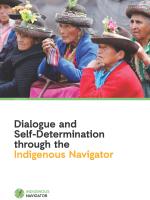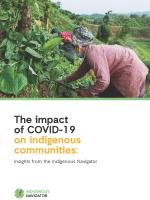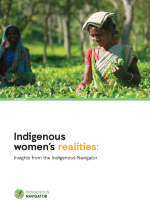Dialogue and Self-Determination through the Indigenous Navigator
This report presents the real-life experiences of Indigenous Peoples as they make their own decisions through the Indigenous Navigator’s tools and resources.
This report shows how the Indigenous Navigator framework has been used not only as a data collection tool, but also as a way to support Indigenous Peoples’ self-determination. In this process, Indigenous Peoples have also seen the need to enhance communication with other communities, local and national governments, and even international organisations. In other words, through the exploration of the Indigenous Navigator data and contact with other actors, Indigenous Peoples have adapted the tools and used them to meet their own needs in a spirit of self-led governance and open dialogue.
The report draws on data collected in collaboration between IWGIA and the Indigenous Navigator consortium, analysing the experiences of Indigenous communities under the UNDRIP and SDG frameworks,[1] which are also at the core of the Indigenous Navigator. In June-August of 2020, the Indigenous Navigator conducted a series of surveys and interviews with national partner organisations and coordinators from all 11 countries participating in the initiative: Bangladesh, Bolivia, Cambodia, Cameroon, Colombia, Kenya, Nepal, Peru, the Philippines, Suriname and Tanzania. This covered more than 200 participating Indigenous communities. The data gathered and submitted by the communities, individuals and national partner organisations were collected and shared with their consent. The information was analysed and coded according to topics related to the abovementioned frameworks, which are central to the Indigenous Navigator.
After using the Indigenous Navigator to turn their priorities into real-life projects, a key commonality experienced by participants is the sense of autonomy to organise themselves, and take action. Through the data collection tool, the advocacy component and the small grants facility, Indigenous communities have reasserted their self-determination, and been able to seek the respect and implementation of their rights at all levels – local, regional, state and international. Common key challenges still remain, especially as regards Indigenous peoples’ rights to lands, territories, and resources, consultations and free prior and informed consent, as well as equal political representation to ensure development opportunities in the economic, health, and education sectors. What is most apparent is the need to continue providing opportunities for all stakeholders to access data to extend the geographic areas of action of the Indigenous Navigator to increase dialogue and improve communication, as well as the critical role Indigenous Peoples and communities serve in achieving the Sustainable Development Goals when they are empowered to do so.
The advent of the COVID-19 pandemic added to the challenges that Indigenous Peoples face on a daily basis. In October 2020, the Indigenous Navigator launched a report to document the experiences of the Indigenous communities that are currently working with the Indigenous Navigator during the pandemic. The report highlighted how preventive measures against the virus and community assessments were insufficient, as well as to what extent the livelihoods of Indigenous Peoples were affected by pandemic mitigation efforts, and the slowing global economy. Conclusions emphasised the urgent need to respect labour and land rights.[2] This report also analyses how the COVID-19 pandemic proved to be a challenge to Indigenous Peoples, but how these resorted to the Indigenous Navigator and their own knowledge to overcome the additional burden that the pandemic brought to their daily struggle towards the fulfilment of their rights.
In the pages that follow, selected topics from these interviews are discussed, supported by direct quotes, additional material made by the partnering organisations and readily available online, and legal and academic texts that provide additional input to the analysis.
The report starts with a brief introduction to the Indigenous Navigator. Then, it moves on by presenting the factual achievements of the initiative, followed by the persistent challenges towards Indigenous wellbeing. It finally discusses the possibilities to improve the framework and tools based on suggestions made by Indigenous Peoples. Each section refers to the linkages between the UNDRIP and the SDGs, which represent key elements of the Indigenous Navigator framework, as well as COVID-19 boxes emphasising the issue.
[1] The Indigenous Navigator is also directly connected to other international instruments which protect Indigenous Peoples rights, namely, the ILO Indigenous and Tribal Peoples Convention, 1989 (No. 169), the International Covenant on Civil and Political Rights (ICCPR), the International Covenant on Economic, Social and Cultural Rights (ICESCR), the Universal Declaration of Human Rights (UDHR), the Convention on the Rights of the Child (CRC), the Convention on the Elimination of All Forms of Discrimination against Women (CEDAW), the International Convention on the Elimination of All Forms of Racial Discrimination (ICERD) and the Convention against Torture (CAT).
[2] Gabriela Balvedi Pimentel, Maria Victoria Cabrera Ormaza and Pedro Cayul, The Impact of COVID on Indigenous Communities: Insights from the Indigenous Navigator (Copenhagen, DK: International Work Group for Indigenous Affairs and International Labour Organisation, 2020), https://www.ilo.org/gender/Informationresources/Publications/WCMS_757475/lang--en/index.htm

Contact





